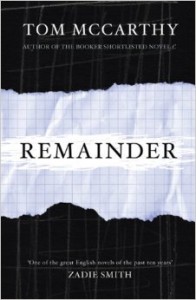I was published in several collections of new writers alongside various people. Some of these are quite famous now – Ben Okri, Iain Sinclair, Hanif Kureishi etc. I also checked out Tom McCarthy. I knew he had set up a sort of one-man art movement called the Necronautical Society, which reminded me of Stewart Home’s various made-up organisations with grand names. I think all that starts from Throbbing Gristle and their manifestos and cut-up art, rather than the Surrealists et al. Most things like this originate in mass culture not high arts. These organisations are a bit dated now as they are too ponderous, claiming irony in their bogus corporate stance. There is nothing more ironic than an out-of-date joke.

This is all about the USP, since a film script starts with a unique pitch line – and Remainder is one of those strange stories that is unusual enough to film. It has made the journey from a small press publication in Paris, all the way to Waterstones deals, and a film.
The USP, the great concept? Someone with brain damage and lots of money decides to recreate moments from his memory (‘re-enactments’) that produce sensations (affect) in his largely blank emotive state. He recreates a whole building he lived in, and then walks around reliving states of emotion or sensation, listening to a pianist, or smelling cooking. This is a kind of reverse of normal, where the real world impinges, in this, he impinges on a created world. Actually his ambitions are quite small, he does not build entirely new places, just uses existing places and adapts them.
This reminded me of the film ‘Synecdoche, New York’ with the recreation of worlds in 1:1 scale, but separate from the world. This sort of thing is always written about as if a requirement is madness. In the real world (as opposed to literary fantasy) people force reality into all sorts of shapes, as a matter of course.
I was also reminded of people who obsessively model railways in various scales, for the pleasure of observing the final result (since they are not playing trains). These people (usually quite old, or retired) are known as ‘rivet counters’ as they model steam engines or trackside buildings, along with tiny people. This could be a senile effect, a longing for an ordered world, located in an ossified childhood memory. I suppose collecting anything old is similar, such as vinyl records once owned when young. The object is not the point, it is the emotional state when observing.
Also:
“What do you consider the largest map that would be really useful?”
“About six inches to the mile.”
“Only six inches!” exclaimed Mein Herr. “We very soon got six yards to the mile. Then we tried a hundred yards to the mile. And then came the grandest idea of all! We actually made a map of the country, on the scale of a mile to the mile!”
“Have you used it much?” I enquired.
“It has never been spread out, yet,” said Mein Herr: “The farmers objected: they said it would cover the whole country, and shut out the sunlight! So now we use the country itself, as its own map, and I assure you it does nearly as well.” Lewis Carroll (ref. 1)
There is some resonance in the idea of maps and scales, the mind observing and testing itself against a life size reproduction. Even the idea of actual biological reproduction might be played out in these scenarios, although this is missed in McCarthy’s addition of a traditional narrative climax to his story (once a gun appears, it has to be used).
If the re-enactment itself gave birth to a new, real, place, that might have been more interesting. Since this interest in McCarthy’s books came about through his accidental proximity to my own writing in an old short story collection, I might as well mention the idea of ‘copy cities’ I used in my last novel Nnn Goes Mobile. This had some action in a place called Prague II. Virtual and augmented reality will eventually give rise to real-life analogues, where entire cities are reproduced in cheaper locations as low cost alternatives. The map and the territory interrelate.
I will reveal parts of the story here so do not read if avoiding spoilers.
Back to the book. It is written by someone who gets hit on the head by ‘something from the sky’. He gets rehabilitated, gets a large compensation, and then proceeds to recreate as life theatre pieces (‘re-enactments’ in buildings or on the street) memories of places and people so he can basically stare at them and get mental sensations. This is all about mental malfunctioning after brain damage, since his previous life seems normal (his pre-accident best friend, soon forgotten, is a typical noisy youth). There is a bit of philosophy thrown in, but the basic story is quite lean and concentrates on describing the process of setting up the re-enactments. There is a bit of a thriller ending, just to liven it up a bit. These sort of ‘mental state’ stories can go on forever. Some sort of climax is needed, hence the thriller ending.
There is hardly any back story or prolonged characterisation, which is quite refreshing. A few old friends loiter around the start of the book but soon disappear. The project manager who arranges all the re-enactments is minimally described, and acts as a cipher. Overall, an interesting book, and a success. This is a tremendous relief.
By Geoff Davis 2016
Refs:
A real literary movement – Polari
Mental illness and literature
Stephen Fry, Ian McKellen and Melvyn Bragg share stories of how literature can help with mental health problems
The film
1: Lewis Carroll, ‘Sylvie and Bruno Concluded’ 1893 The Complete Illustrated Lewis Carroll Wordsworth Editions Ltd 2001